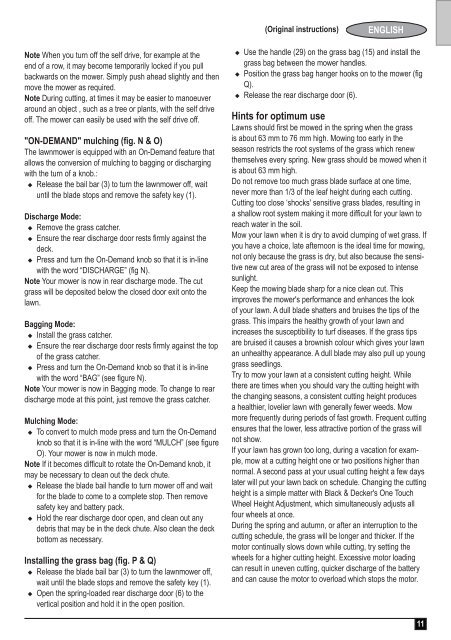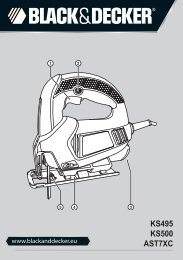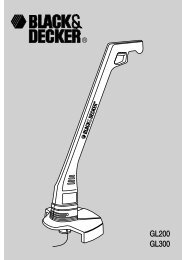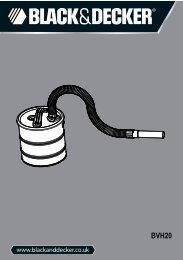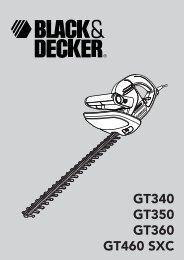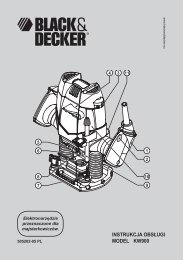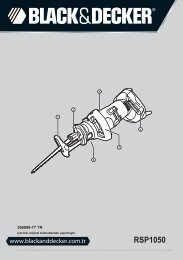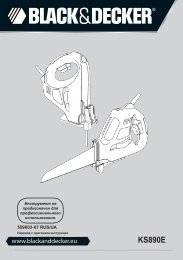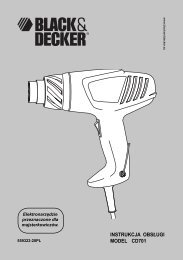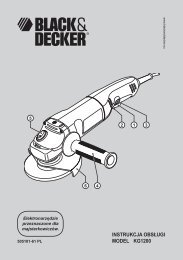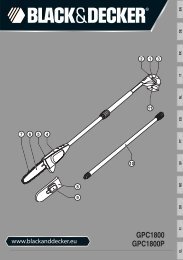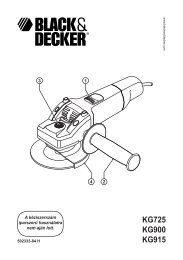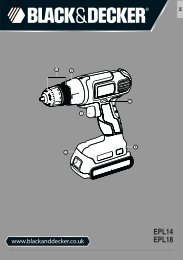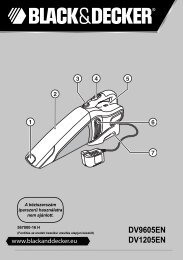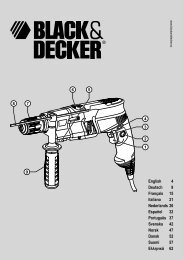GRC4736SD - Service - Black & Decker
GRC4736SD - Service - Black & Decker
GRC4736SD - Service - Black & Decker
Create successful ePaper yourself
Turn your PDF publications into a flip-book with our unique Google optimized e-Paper software.
Note When you turn off the self drive, for example at the<br />
end of a row, it may become temporarily locked if you pull<br />
backwards on the mower. Simply push ahead slightly and then<br />
move the mower as required.<br />
Note During cutting, at times it may be easier to manoeuver<br />
around an object , such as a tree or plants, with the self drive<br />
off. The mower can easily be used with the self drive off.<br />
"ON-DEMAND" mulching (fig. N & O)<br />
The lawnmower is equipped with an On-Demand feature that<br />
allows the conversion of mulching to bagging or discharging<br />
with the turn of a knob.:<br />
u Release the bail bar (3) to turn the lawnmower off, wait<br />
until the blade stops and remove the safety key (1).<br />
Discharge Mode:<br />
u Remove the grass catcher.<br />
u Ensure the rear discharge door rests firmly against the<br />
deck.<br />
u Press and turn the On-Demand knob so that it is in-line<br />
with the word “DISCHARGE” (fig N).<br />
Note Your mower is now in rear discharge mode. The cut<br />
grass will be deposited below the closed door exit onto the<br />
lawn.<br />
Bagging Mode:<br />
u Install the grass catcher.<br />
u Ensure the rear discharge door rests firmly against the top<br />
of the grass catcher.<br />
u Press and turn the On-Demand knob so that it is in-line<br />
with the word “BAG” (see figure N).<br />
Note Your mower is now in Bagging mode. To change to rear<br />
discharge mode at this point, just remove the grass catcher.<br />
Mulching Mode:<br />
u To convert to mulch mode press and turn the On-Demand<br />
knob so that it is in-line with the word “MULCH” (see figure<br />
O). Your mower is now in mulch mode.<br />
Note If it becomes difficult to rotate the On-Demand knob, it<br />
may be necessary to clean out the deck chute.<br />
u Release the blade bail handle to turn mower off and wait<br />
for the blade to come to a complete stop. Then remove<br />
safety key and battery pack.<br />
u Hold the rear discharge door open, and clean out any<br />
debris that may be in the deck chute. Also clean the deck<br />
bottom as necessary.<br />
Installing the grass bag (fig. P & Q)<br />
u Release the blade bail bar (3) to turn the lawnmower off,<br />
wait until the blade stops and remove the safety key (1).<br />
u Open the spring-loaded rear discharge door (6) to the<br />
vertical position and hold it in the open position.<br />
(Original instructions)<br />
ENGLISH<br />
u Use the handle (29) on the grass bag (15) and install the<br />
grass bag between the mower handles.<br />
u Position the grass bag hanger hooks on to the mower (fig<br />
Q).<br />
u Release the rear discharge door (6).<br />
Hints for optimum use<br />
Lawns should first be mowed in the spring when the grass<br />
is about 63 mm to 76 mm high. Mowing too early in the<br />
season restricts the root systems of the grass which renew<br />
themselves every spring. New grass should be mowed when it<br />
is about 63 mm high.<br />
Do not remove too much grass blade surface at one time,<br />
never more than 1/3 of the leaf height during each cutting.<br />
Cutting too close ‘shocks' sensitive grass blades, resulting in<br />
a shallow root system making it more difficult for your lawn to<br />
reach water in the soil.<br />
Mow your lawn when it is dry to avoid clumping of wet grass. If<br />
you have a choice, late afternoon is the ideal time for mowing,<br />
not only because the grass is dry, but also because the sensitive<br />
new cut area of the grass will not be exposed to intense<br />
sunlight.<br />
Keep the mowing blade sharp for a nice clean cut. This<br />
improves the mower's performance and enhances the look<br />
of your lawn. A dull blade shatters and bruises the tips of the<br />
grass. This impairs the healthy growth of your lawn and<br />
increases the susceptibility to turf diseases. If the grass tips<br />
are bruised it causes a brownish colour which gives your lawn<br />
an unhealthy appearance. A dull blade may also pull up young<br />
grass seedlings.<br />
Try to mow your lawn at a consistent cutting height. While<br />
there are times when you should vary the cutting height with<br />
the changing seasons, a consistent cutting height produces<br />
a healthier, lovelier lawn with generally fewer weeds. Mow<br />
more frequently during periods of fast growth. Frequent cutting<br />
ensures that the lower, less attractive portion of the grass will<br />
not show.<br />
If your lawn has grown too long, during a vacation for example,<br />
mow at a cutting height one or two positions higher than<br />
normal. A second pass at your usual cutting height a few days<br />
later will put your lawn back on schedule. Changing the cutting<br />
height is a simple matter with <strong>Black</strong> & <strong>Decker</strong>'s One Touch<br />
Wheel Height Adjustment, which simultaneously adjusts all<br />
four wheels at once.<br />
During the spring and autumn, or after an interruption to the<br />
cutting schedule, the grass will be longer and thicker. If the<br />
motor continually slows down while cutting, try setting the<br />
wheels for a higher cutting height. Excessive motor loading<br />
can result in uneven cutting, quicker discharge of the battery<br />
and can cause the motor to overload which stops the motor.<br />
11


